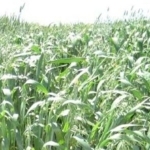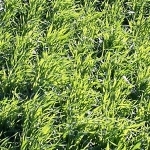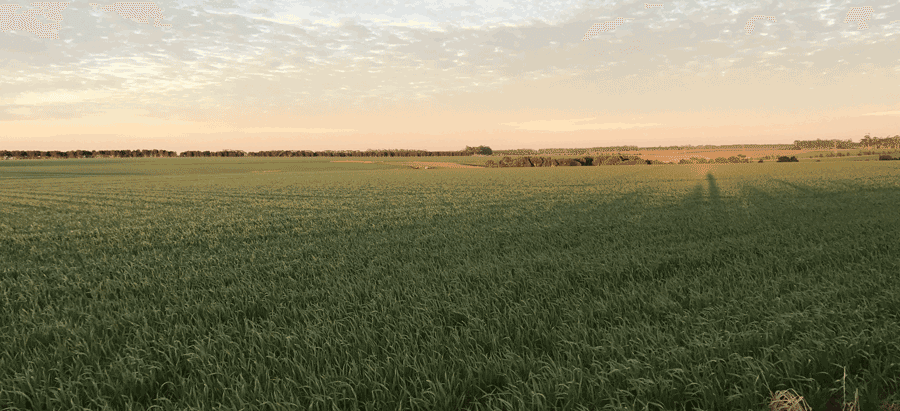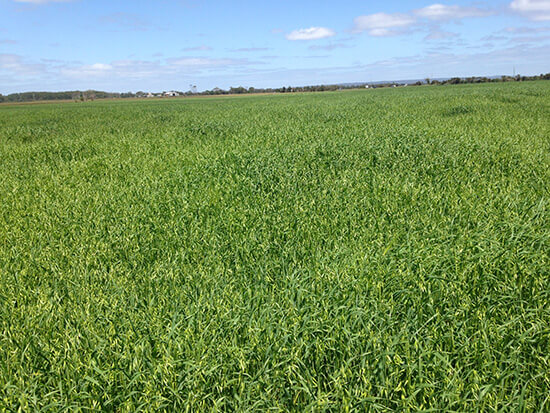Forage cereals have a higher winter growth rate than most pasture options. Growth rates can vary based on the species, but generally cereals offer flexibility to any farming operation through sowing, grazing and silage or hay.
Cereals also play an important role in paddock preparation and weed control. Oats generally provide the most forage of all cereal crops. However, they can all be grazed very satisfactorily. Forage cereals can be harvested either as a cut and wilted crop or direct cut and ensiled.

Forage Oats
Oats are a good robust dual purpose cereal for graziers around Australia that can be grazed during the winter months prior to being shut up to be cut for hay. Oats are a great source of on-farm hay production that can be sown as a monoculture or blended with other species such as Bullet Annual Ryegrass or Surge Italian ryegrass and clovers to increase yield and quality. Oats prefer If paddocks are prone to waterlogging then annual or italian ryegrasses are a better option.

Forage Ryecorn
Ryecorn is a species of cereal that has been commonly grown on the sandy outlays of the Mallee regions of South Australia and Victoria. A versatile species that tolerates very dry conditions and grows well on sandy soil types. Performs best when grown on good fertile soils that will respond well to nitrogen applications to gain the most out of the shorter growing season. Minimum annual rainfall is 300mm p.a.

Forage Tritcale
Triticale is a high yielding whole-crop cereal suited to a range of growing conditions with a focus on maximising production of dry matter and conserving fodder (entire crop cut, chopped and stored via pit or wrapped silage). A cross between wheat and rye, Triticale combines the quality and yield of wheat and the versatility of rye.
More on Forage Cereals
Cereal grazing serves two purposes; the use of green feed at a time when available feed is generally low and increasing the yield potential by encouraging more tillers and greater root growth.
The utilisation of green feed early in the season allows for a longer rotation and therefore allowing for longer resting times for other pastures, especially the perennial pastures which can take longer to reach adequate dry matter yields for grazing
Increased yield potential is important given that cereals are only a short term option.
The reason why cereals generally produce more feed when grazed is because the shock of the grazing forces the plant to produce secondary tillers as well as secondary roots. The more tillers produced, the higher the potential for more dry matter to be grown.
Our Top Recommendations
High yielding, quick winter feed option
Southern Green Ryecorn is an exceptionally fast establishing grazing option particularly when sown late into cold conditions. Southern Green can be up and ready to graze three weeks before oats and when managed correctly can offer multiple grazing opportunities. Unlike common ryecorn, Southern Green produces high quality feed at a time when feed is in short supply.
Quick winter grazing and quality spring feed
Cooee® is a versatile, fast growing, winter forage oat that provides good winter to early spring feed. One of the features of Cooee® oats is its broader style leaves that, when used in a hay production system, offer the benefits of higher quality conserved feed. Cooee® oats is adapted to a wide range of soil types and has been bred for resistance to leaf rust and good tolerance to Barley Yellow Dwarf Virus (BYDV).
Harvesting Forage Cereals For Silage
- Whether it is intended for animal finishing systems or simply maintenance rations
- The quality of the dry matter yield you are seeking
- The soil types and anticipated weather conditions at harvest
- If spring sowing, when the follow-up pasture needs to be sown
- If double cropping, when the follow-up crop needs to be sown
- If you have access to the correct harvesting equipment
Grazing Forage Cereals
It is important to ensure that grazing is not too low into the crown of the plant and to allow some leaf area to be left behind which allows the plant to recover quicker.
Time of grazing should cease once the day length and day time temperatures are increasing and general daily growth rates are increasing. The timing for this is late winter into very early spring, which should also coincide with the growth rates of the other pasture crops/paddocks increasing in daily dry matter production and therefore meet the increasing requirement of the livestock production system.
It is also important to monitor soil moisture as this will have a large impact on the final yield potential of any hay or silage crop.
Additional Forage Cereal Options
Endeavour Triticale
A dual purpose triticale with excellent dry matter production and grain recovery after grazing. Endevour can be sown early and grazed or sown later and left ungrazed for high quality hay/silage. Resistant to leaf, stem and stripe rust.
Sowing Rate: 100-150 kg/ha
Common Ryecorn
Economical option for filling the feed gap in autumn and winter, Common Ryecorn is winter forage choice for its speed to first grazing in cool climates. Its deep roots provide a reliable forage base in drought years. Can be used in mixes at 20-40kg/ha
Sowing Rate: 80-100 kg/ha
Saia Oats
Saia Oats fast to establish and will provide good quality early winter feed if planted around late March or early April. Saia Oats, a tall fine stemmed black seeding oat, rebounds well after grazing and grows in a wide range of soil types and has a good tolerance of acid soils. Combine with annual ryegrass for winter bulk pastures.
Sowing Rate: 60-100 kg/ha
Boost winter growth with Accelerate
Accelerate 200 SG Growth Regulant is a naturally occurring plant hormone that has been maximising pasture growth during the cooler months to deliver quality feed quantity during periods of reduced winter pasture production.










